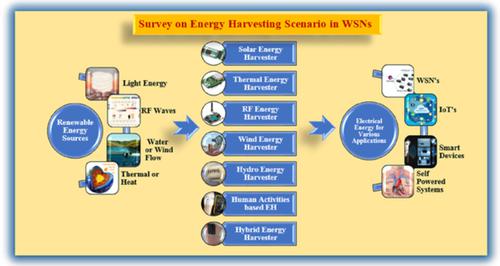当前位置:
X-MOL 学术
›
Int. J. Energy Res.
›
论文详情
Our official English website, www.x-mol.net, welcomes your feedback! (Note: you will need to create a separate account there.)
Energy harvesting in wireless sensor networks: A taxonomic survey
International Journal of Energy Research ( IF 4.6 ) Pub Date : 2020-09-14 , DOI: 10.1002/er.5816 Jaspreet Singh 1 , Ranjit Kaur 1 , Damanpreet Singh 2
International Journal of Energy Research ( IF 4.6 ) Pub Date : 2020-09-14 , DOI: 10.1002/er.5816 Jaspreet Singh 1 , Ranjit Kaur 1 , Damanpreet Singh 2
Affiliation

|
Wireless sensor networks (WSNs) have aroused the conspectus attention of scholars due to their extensive deployment in the emerging fields of the Internet of Things (IoT's) and self‐driven devices. But WSNs technologies having a major bottleneck has been associated with limited energy. Mostly research in WSNs has been focused on minimizing energy usage to extend the survival time of limited power source in a network. Energy harvesting can be addressing its energy‐scarcity problem of WSNs, so it is giving popularity to Energy Harvesting in Wireless Sensor Networks (EH‐WSNs). The paper presents a comprehensive taxonomic survey on recently energy harvesting techniques and algorithms that proposed by various authors and also examined the work done by the various researchers in the field of EH‐WSNs. For the ready reference of the researchers, a concise summary and comparative analysis of various promising techniques for energy harvesting have also been included in the systematic survey. However, many equipment developed using the hybridization method in a singular package to get full advantages of available free energy, are explored in this review. The review on hybrid energy harvesting (HEH) systems can be considered as the originality of this article. However, the outdoor photovoltaics have been provided maximum power density about ≈100 mW/cm3, and the piezoelectric harvesters have been given maximum voltage about 325 V but the current in very minute amount. The thermoelectric, rectenna and hybrid energy harvesters (EHs) have been given high efficiency more than 80%. Additionally, hybrid EHs have location/time‐independent characteristics which harnessed power from more than one source that can be became more popular for upcoming leading technologies of self‐driven or autonomous devices shifting from battery operated devices. Finally, the survey also identifies often challenges and various significant issues that still essential to be addressed to develop a cost effective, efficient, long‐lasting, and almost maintenance‐free energy harvesting systems for WSNs along with trail to their possible solutions for future perspectives.
中文翻译:

无线传感器网络中的能量收集:分类学调查
由于无线传感器网络(WSN)在物联网(IoT)和自动驱动设备等新兴领域中的广泛部署,引起了学者的广泛关注。但是,无线传感器网络技术存在重大瓶颈,但能源消耗却有限。在无线传感器网络中,大多数研究都集中在最大程度地减少能耗以延长网络中有限电源的生存时间上。能量收集可以解决其WSN的能源稀缺问题,因此它正在普及到无线传感器网络(EH-WSN)中的能量收集。本文介绍了由多位作者提出的有关最近的能量收集技术和算法的综合分类学调查,并考察了EH-WSNs领域中不同研究人员所做的工作。供研究人员参考,系统调查还包括对各种有前途的能量收集技术的简要总结和比较分析。然而,在本综述中,探索了许多使用杂交方法开发的设备,这些设备采用单一包装,以充分利用可用自由能。对混合式能量收集(HEH)系统的评论可以视为本文的独创性。但是,已为室外光伏提供了约≈100mW / cm的最大功率密度 对混合式能量收集(HEH)系统的评论可以视为本文的独创性。但是,已为室外光伏提供了约≈100mW / cm的最大功率密度 对混合式能量收集(HEH)系统的评论可以视为本文的独创性。但是,已为室外光伏提供了约≈100mW / cm的最大功率密度在图3中,压电收集器被赋予最大电压约325V,但是电流却非常小。热电,整流天线和混合能量收集器(EH)的效率已超过80%。此外,混合EH具有不受位置/时间影响的特性,可以利用来自多个电源的电力,这种自来水或自动驾驶设备从电池供电设备转移过来的领先技术将变得越来越流行。最后,调查还确定了为WSN开发具有成本效益,高效,持久且几乎免维护的能量收集系统时仍需解决的常见挑战和各种重大问题,以及针对未来观点的可行解决方案的线索。
更新日期:2020-09-14
中文翻译:

无线传感器网络中的能量收集:分类学调查
由于无线传感器网络(WSN)在物联网(IoT)和自动驱动设备等新兴领域中的广泛部署,引起了学者的广泛关注。但是,无线传感器网络技术存在重大瓶颈,但能源消耗却有限。在无线传感器网络中,大多数研究都集中在最大程度地减少能耗以延长网络中有限电源的生存时间上。能量收集可以解决其WSN的能源稀缺问题,因此它正在普及到无线传感器网络(EH-WSN)中的能量收集。本文介绍了由多位作者提出的有关最近的能量收集技术和算法的综合分类学调查,并考察了EH-WSNs领域中不同研究人员所做的工作。供研究人员参考,系统调查还包括对各种有前途的能量收集技术的简要总结和比较分析。然而,在本综述中,探索了许多使用杂交方法开发的设备,这些设备采用单一包装,以充分利用可用自由能。对混合式能量收集(HEH)系统的评论可以视为本文的独创性。但是,已为室外光伏提供了约≈100mW / cm的最大功率密度 对混合式能量收集(HEH)系统的评论可以视为本文的独创性。但是,已为室外光伏提供了约≈100mW / cm的最大功率密度 对混合式能量收集(HEH)系统的评论可以视为本文的独创性。但是,已为室外光伏提供了约≈100mW / cm的最大功率密度在图3中,压电收集器被赋予最大电压约325V,但是电流却非常小。热电,整流天线和混合能量收集器(EH)的效率已超过80%。此外,混合EH具有不受位置/时间影响的特性,可以利用来自多个电源的电力,这种自来水或自动驾驶设备从电池供电设备转移过来的领先技术将变得越来越流行。最后,调查还确定了为WSN开发具有成本效益,高效,持久且几乎免维护的能量收集系统时仍需解决的常见挑战和各种重大问题,以及针对未来观点的可行解决方案的线索。



























 京公网安备 11010802027423号
京公网安备 11010802027423号